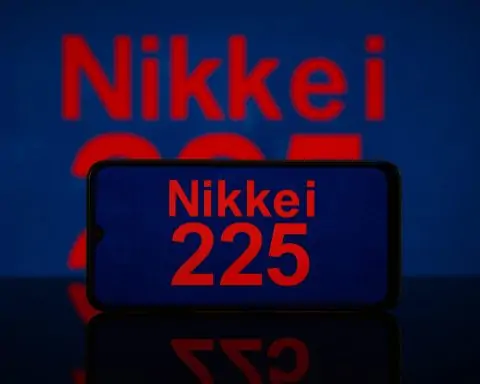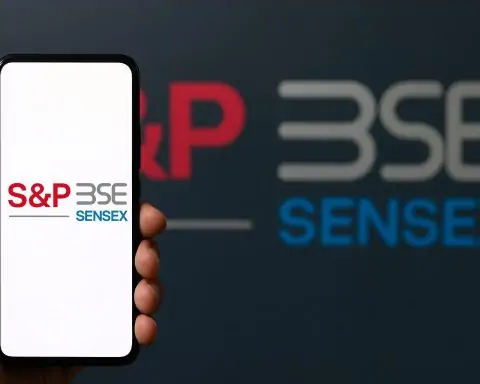- Nvidia earnings hype lifts markets: Investors are eagerly awaiting Nvidia’s quarterly results (due Aug. 27) as a barometer for the AI boom, with the chipmaker expected to post a 53% revenue jump to ~$46 billion [1]. Nvidia’s stock rose ~1.1% on Aug. 26 ahead of the report [2], and its colossal $4.4 trillion market cap now accounts for a record 8% of the S&P 500 [3].
- Major AI stocks rally:AMD leapt ~2% after teaming up with IBM on new “quantum-centric” computing initiatives [4]. Palantir gained ~2% as it continues to secure massive government AI deals [5]. Microsoft and Alphabet (Google) were flat-to-slightly down, while other tech giants like Tesla, Apple, Broadcom, Amazon, and Meta notched modest gains [6].
- China fuels an AI stock surge: Beijing’s State Council unveiled a sweeping “‘AI Plus’” policy initiative to accelerate AI adoption, sparking a 5.5% jump in China’s CSI AI Index to a record high on Aug. 27 [7]. Chinese AI chipmakers and cloud stocks rallied sharply, with Cambricon Technologies soaring ~8–10% to all-time highs after reporting its first-ever profit [8] [9].
- Europe joins the upswing: European semiconductor shares climbed in tandem – the STOXX 600 rose ~0.3% as chipmakers like ASM International, BE Semiconductor, and Infineon were among the top gainers [10]. Analysts say Nvidia’s results will “set the tone” for risk assets; Jefferies’ Europe strategist noted we are “just in the initial phases of the AI business cycle,” albeit with some caution on over-positioning [11].
- Bubble worries vs. AI optimism: The frenzy has also prompted debate about a potential AI bubble. OpenAI CEO Sam Altman cautioned investors may be “overexcited about AI” [12], and an MIT study found 95% of firms see no ROI yet on hefty AI investments [13]. Tech valuations look stretched – e.g. Nvidia trades at ~40× forward earnings – leading some on Wall Street to warn of a pullback. Still, others remain bullish: Morgan Stanley projects nearly $3 trillion in AI-related data center spending by 2028 [14], and Nvidia’s earnings are seen as a “talisman” for the AI trade that could either validate the boom or exacerbate bubble fears [15] [16].
Wall Street Rallies Ahead of Nvidia’s AI ‘Moment of Truth’
U.S. markets climbed on Aug. 26 as investors braced for Nvidia’s highly anticipated earnings release, which has been likened to an economic event in its significance [17]. The Dow Jones rose about 0.3%, and the S&P 500 and Nasdaq each gained ~0.4%, finishing near session highs [18]. Nvidia – now the world’s most valuable company at roughly $4.4 trillion market cap – has become the de facto bellwether of the AI era [19]. Its results “transcend the company, becoming a barometer of macroeconomic activity, a talisman for the artificial intelligence trade, and a critical pressure point for global geopolitics,” one analyst observed [20]. Wall Street expects blockbuster numbers: consensus estimates forecast 53% revenue growth (to ~$46 billion) and a 49% EPS jump for the quarter, surpassing Nvidia’s own upbeat guidance [21] [22]. Any surprise – good or bad – could send shockwaves through tech stocks worldwide.
Nvidia’s stock ticked up +1.1% on Tuesday ahead of the report [23]. Other mega-cap tech names mostly rose in sympathy: Tesla jumped 1.5%, Apple about 1%, and Amazon and Meta posted modest gains [24]. Microsoft and Alphabet (Google) lagged slightly, each edging down under 0.5% [25] as investors rotated into more AI-centric plays. Chipmaker AMD surged ~2% after IBM announced a partnership with AMD to develop “quantum-centric” supercomputing systems that blend AI with quantum computing [26]. In addition, chip stocks Marvell Technology and Qualcomm climbed roughly 2% each [27], riding the broader semiconductor strength.
Meanwhile, Palantir Technologies – often viewed as an emerging AI leader – saw its stock rise about 2.3% to $160.84 [28], continuing an impressive uptrend. “Palantir has been a major winner from public sector investment in AI tools throughout 2025,” the Motley Fool notes [29]. The data analytics firm’s platforms have become “indispensable for mission-critical operations” in the U.S. Defense Department [30], translating into a wave of government contracts. Just last month Palantir clinched a $10 billion Army software deal – its largest contract ever [31] – cementing its role as a key AI provider to the military. Despite recent headlines about insider stock sales by Palantir’s CEO (and some short-seller pressure), robust demand for its AI solutions has kept buyers coming [32]. In fact, Palantir’s stock is up over 110% year-to-date as of late August [33], making it one of 2025’s top-performing AI stocks. Its strength stood out on Aug. 26, especially as peers like Snowflake and Datadog (other data/cloud names) traded down that day [34]. Investors will be watching whether Palantir can sustain this momentum into its next earnings report, which is looming as another catalyst [35].
Europe’s Chipmakers Climb with Nvidia in Focus
European markets mirrored the U.S. optimism. On Aug. 27, the pan-European STOXX 600 index rose about 0.3% in early trading, led by semiconductor and tech stocks [36]. Chip equipment suppliers and silicon firms like ASM International, BE Semiconductor Industries, and Infineon Technologies were among the biggest gainers [37], as traders positioned ahead of Nvidia’s earnings. U.S. stock futures were essentially flat in the European morning, but clearly Nvidia’s report was the market’s focal point. “Today’s focus will be on Nvidia earnings, which is likely to set the tone for risky assets over the coming days,” said Mohit Kumar, chief Europe economist at Jefferies [38]. He added that the bank remains bullish on tech, believing we are only “in the initial phases of the AI business cycle,” though he cautioned that equities could see a pullback in the short term due to crowded positioning [39].
Not everything was rosy in Europe – local factors like political unrest in France and renewed U.S.-EU trade tensions (including tariff threats from Washington) kept some investors on edge [40]. France’s CAC 40 index underperformed slightly amid domestic uncertainties [41]. However, these concerns were overshadowed by the global AI story, as Europe’s tech sector rode the wave of enthusiasm. Even outside the U.S., Nvidia’s influence is palpable: as one strategist noted, Nvidia’s performance and guidance will provide crucial clues on “the sustainability of massive AI spending, and how the US-China rivalry is limiting growth” in the sector [42]. In other words, European investors see Nvidia’s “moment of truth” as a proxy for the health of the entire AI ecosystem that has powered stock gains this year. The upbeat mood in Europe underscores how interconnected global markets have become around the AI theme. As long as Nvidia delivers solid results and guidance, it could affirm the bull case for tech stocks worldwide. But a miss or cautious outlook might quickly sour sentiment across continents.
China’s ‘AI Plus’ Policy Ignites an AI Stock Boom
The most dramatic AI stock moves came out of Asia, where China’s markets staged a powerful rally on Aug. 27 after Beijing doubled down on support for its tech sector. Late on Aug. 26, China’s State Council released a new “AI Plus” initiative – a comprehensive guideline to accelerate AI adoption across various industries and consumer applications [43]. This policy boost sent Chinese investors piling into anything AI-related. By midday Wednesday in Hong Kong and Shanghai, AI, cloud computing, and semiconductor shares were broadly surging [44].
Notably, China’s CSI AI Industry Index rocketed 5.5% by midday, hitting an all-time high [45]. The benchmark Shanghai Composite was up a more modest 0.3%, but AI-linked stocks far outpaced the broader market. Semiconductor stocks jumped ~4% on average [46], and the tech-heavy Shenzhen board rallied over 2%. In Hong Kong, the Hang Seng Tech Index climbed 0.6% despite a flat overall Hang Seng, reflecting strength in mainland-focused AI names [47].
One standout was Cambricon Technologies, often dubbed “China’s little Nvidia.” Cambricon – a leading domestic AI chip designer – saw its shares spike over 8% to a record high [48] after the company announced a swing to profitability in the first half of 2025. Goldman Sachs analysts predict Cambricon’s AI chip shipments will explode over the coming years, and investors are betting it will be a prime beneficiary of China’s AI push [49]. The policy tailwinds also lifted other Chinese tech giants: cloud and AI service providers, software firms, and hardware makers all notched strong gains on Aug. 27.
“This development represents a powerful catalyst for growth stocks and related subsectors,” investment firm KraneShares said in a note, referring to Beijing’s AI Plus plan [50]. The initiative is seen as part of China’s broader effort to bolster tech innovation amid a slowing economy. By infusing AI into everything from manufacturing to consumer apps, officials aim to spur new growth drivers. However, some experts urged caution. UBS Global Wealth Management noted that China’s macroeconomic backdrop remains weak – recent data showed industrial profits falling for a third straight month in July [51]. “The lifespan of this equity rally remains uncertain,” UBS analysts wrote, warning that without improvement in fundamentals, the AI stock euphoria could be short-lived [52]. They expect investors will look toward a key Communist Party meeting in October for more substantive measures to support the economy [53].
In the near term though, Beijing’s clear pro-AI stance has unleashed animal spirits in China’s markets. The government’s encouragement of AI adoption (paired with recent support for chip manufacturing and software) suggests that China is determined to cultivate its own AI champions. Global investors will be watching how U.S. export controls and geopolitical tensions play into this – Nvidia’s sales to China, for instance, have been under U.S. restrictions, which the company said could cost it billions in lost revenue [54] [55]. Intriguingly, reports indicate the U.S. administration (under President Trump, as of 2025) may have eased some chip export rules in exchange for a government revenue share, highlighting how geopolitics and business are intersecting in the AI race [56]. All told, China’s “AI Plus” boom on Aug. 27 added an exclamation point to the global AI stock story, even as it raises the stakes in the U.S.-China tech rivalry.
Boom, Bubble, or Both? Experts Split on AI Stock Mania
Amid the market’s enthusiasm, a debate is raging: Are AI stocks in a justified boom, or a speculative bubble? The past six months have seen breathtaking gains – Nvidia has more than doubled, Palantir is up 75%+ in six months [57], and the “Magnificent Seven” mega-cap U.S. tech firms collectively added trillions in market value thanks to AI hype. The S&P 500 itself has climbed roughly 68% since the end of 2022, largely on AI optimism [58]. This euphoria has drawn comparisons to the late-1990s dot-com bubble. Sam Altman, who helped spark the AI revolution as CEO of OpenAI, has publicly mused that “investors as a whole are overexcited about AI” – “my opinion is yes,” he said when asked if we’re in an AI hype phase [59]. That sentiment was amplified by a recent MIT study indicating 95% of companies are seeing zero return on their billions poured into generative AI projects so far [60]. In other words, despite widespread experimentation with tools like ChatGPT and Microsoft’s Copilot, most firms have yet to translate AI into bottom-line gains [61]. Such findings have made some investors jittery that the AI emperor has no clothes, at least in the short term.
Those nerves showed through last week, when tech stocks stumbled before Nvidia’s rally rekindled the uptrend. By mid-August, the Nasdaq’s big-tech index had pulled back ~1%, while more value-oriented small caps rallied – a hint of rotation away from crowded AI trades [62]. “The rubber band for tech stretched too far – at least in the short term,” cautioned Keith Lerner, co-CIO at Truist Advisory, noting that mega-cap tech had become “overcrowded and vulnerable to negative headlines” after its historic 50% surge since spring [63]. Bears argue that if Nvidia (or any AI darling) were to disappoint, it could trigger a sharp correction. Indeed, Nvidia’s own valuation is lofty by any standard – recently about 40× forward earnings, roughly double what is considered a normal growth stock multiple [64]. Microsoft now flirts with a $4 trillion valuation as well [65], and Alphabet, Amazon, Meta are all in the ~$2 trillion club [66]. Such rich pricing leaves little margin for error if the AI boom thesis falters.
On the other hand, long-term believers contend that we are only at the beginning of a multi-year AI supercycle. They point to concrete spending commitments: the top seven U.S. tech companies (“Magnificent Seven”) have collectively pledged hundreds of billions of dollars for AI investments in the coming years [67]. Morgan Stanley analysts predict nearly $3 trillion will be spent globally on AI-centric data centers by 2028 (with annual AI infrastructure capex hitting $900+ billion by that year) [68]. Consultants at McKinsey go even further, estimating $6.7 trillion in worldwide data center investment may be needed by 2030 to keep up with AI demand [69]. These staggering figures suggest an entire economy being built around AI – spanning chips, cloud services, software, and networking – which could drive years of growth for industry leaders. “Overall, we remain bullish on the tech sector… we believe that we are just in the initial phases of the AI business cycle,” the Jefferies team reiterated [70], echoing a view that AI’s transformative impact (from enterprise productivity to consumer applications) is only starting to be realized.
The truth may lie somewhere in between hype and reality. Nvidia’s earnings this week have effectively become a referendum on the AI boom. As Reuters put it, Nvidia’s release is now “almost akin to U.S. GDP or inflation statistics” in its market impact [71]. A blowout report could calm the AI jitters and reinforce faith that surging AI demand – from cloud giants, startups, and enterprises alike – will indeed translate into earnings power [72]. In that scenario, the AI rally could accelerate into the fall, carrying not just Nvidia but the broader tech sector and even indexes to new highs. Conversely, any hint of slower growth or cautious outlook from Nvidia might puncture the exuberance. Given how “stretched” positioning has become, a negative shock could spur a swift pullback or rotation out of tech, as evidenced by the quick corrections earlier this year when AI hype momentarily dimmed [73].
For now, markets are in wait-and-see mode – riding the updraft of AI optimism, but well aware of the lofty expectations baked into prices. The next 48 hours of August 26–27, 2025 have shown how sensitive global stocks are to the AI narrative: from Wall Street to Shanghai, traders are trading on the promise of artificial intelligence. Expert opinions remain divided. Some, like Altman and a chorus of cautious analysts, urge sobriety and remind investors of the dot-com lessons. Others, like the team at Jefferies or strategists at Capital.com, argue that AI’s potential is so far-reaching that today’s valuations will be vindicated as earnings catch up. “Nvidia’s results transcend the company,” wrote analyst Kyle Rodda, “becoming a barometer for…the artificial intelligence trade” [74]. In short, Nvidia’s “moment of truth” will not just determine the fate of one $4 trillion company – it may well set the tone for the entire AI stock saga in the months ahead [75].
Sources:
- Investopedia – Markets News, Aug. 26, 2025: Stocks Close Higher as Investors Brush Aside Concerns; Nvidia Earnings Coming [76] [77]
- Reuters – Can Nvidia results dispel creeping AI doubts? [78] [79] [80]
- Bloomberg (via Swissinfo) – European Shares Rise With Nvidia Earnings in Focus [81] [82] [83]
- Business Recorder/Reuters – China stocks rise as AI sector takes the lead [84] [85]
- Motley Fool via Nasdaq – Palantir’s Game-Changing Government Deal [86] [87]
- Nasdaq (Motley Fool) – Stock Market Today: Palantir Rises 2% [88] [89]
- Associated Press via Inkl/Independent – Nvidia’s quarterly report will gauge the temperature of the AI craze [90] [91]
References
1. www.reuters.com, 2. www.investopedia.com, 3. www.reuters.com, 4. www.investopedia.com, 5. www.nasdaq.com, 6. www.investopedia.com, 7. www.brecorder.com, 8. www.brecorder.com, 9. www.swissinfo.ch, 10. www.swissinfo.ch, 11. www.swissinfo.ch, 12. www.reuters.com, 13. www.reuters.com, 14. www.reuters.com, 15. www.swissinfo.ch, 16. www.reuters.com, 17. www.reuters.com, 18. www.investopedia.com, 19. www.reuters.com, 20. www.swissinfo.ch, 21. www.reuters.com, 22. www.inkl.com, 23. www.investopedia.com, 24. www.investopedia.com, 25. www.investopedia.com, 26. www.investopedia.com, 27. www.investopedia.com, 28. www.nasdaq.com, 29. www.nasdaq.com, 30. www.nasdaq.com, 31. www.axios.com, 32. www.nasdaq.com, 33. www.nasdaq.com, 34. www.nasdaq.com, 35. www.nasdaq.com, 36. www.swissinfo.ch, 37. www.swissinfo.ch, 38. www.swissinfo.ch, 39. www.swissinfo.ch, 40. www.swissinfo.ch, 41. www.swissinfo.ch, 42. www.swissinfo.ch, 43. www.brecorder.com, 44. www.brecorder.com, 45. www.brecorder.com, 46. www.brecorder.com, 47. www.brecorder.com, 48. www.brecorder.com, 49. www.morningstar.com, 50. www.brecorder.com, 51. www.brecorder.com, 52. www.brecorder.com, 53. www.brecorder.com, 54. www.inkl.com, 55. www.inkl.com, 56. www.inkl.com, 57. www.investopedia.com, 58. www.inkl.com, 59. www.reuters.com, 60. www.reuters.com, 61. www.reuters.com, 62. www.reuters.com, 63. www.reuters.com, 64. www.inkl.com, 65. www.inkl.com, 66. www.inkl.com, 67. www.reuters.com, 68. www.reuters.com, 69. www.reuters.com, 70. www.swissinfo.ch, 71. www.reuters.com, 72. www.reuters.com, 73. www.investopedia.com, 74. www.swissinfo.ch, 75. www.swissinfo.ch, 76. www.investopedia.com, 77. www.investopedia.com, 78. www.reuters.com, 79. www.reuters.com, 80. www.reuters.com, 81. www.swissinfo.ch, 82. www.swissinfo.ch, 83. www.swissinfo.ch, 84. www.brecorder.com, 85. www.brecorder.com, 86. www.nasdaq.com, 87. www.axios.com, 88. www.nasdaq.com, 89. www.nasdaq.com, 90. www.inkl.com, 91. www.inkl.com








